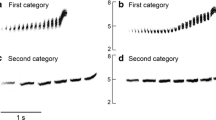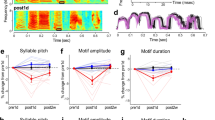Abstract
One explanation for why female songbirds attend to male song is that the quality of a male's song is associated with the quality of his developmental history. We tested this hypothesis by playing back to female swamp sparrows (Melospiza georgiana) songs recorded from males of either inferior or superior developmental histories, as assessed by their rates of mass gain during the first 18 days post-hatching. Females showed significantly higher levels of courtship display in response to songs of males with superior growth than to songs of males with inferior growth. Out of nine song traits measured, only song duration correlated with variation in female response; duration was also the only trait that differed significantly in univariate comparisons between the superior growth songs and the inferior growth songs. In a multivariate analysis, however, inferior growth songs were best discriminated from superior growth songs by combining three song traits: trill rate, stereotypy, and the number of notes per syllable. We suggest that early developmental stress degrades song in many small ways, and that it is the cumulative effect of the resulting deficits that explains lower female response.


Similar content being viewed by others
References
Anderson RC (2009) Operant conditioning and copulation display assays reveal a stable preference for local song by female swamp sparrows Melospiza georgiana. Behav Ecol Sociobiol 64:215–223
Arcese P, Smith JNM, Hochachka WM, Rogers CM, Ludwig D (1992) Stability, regulation, and the determination of abundance in an insular song sparrow population. Ecology 73:805–822
Ballentine B, Hyman J, Nowicki S (2004) Vocal performance influences female response to male bird song: an experimental test. Behav Ecol 15:163–168
Brumm H, Zollinger SA, Slater PJB (2009) Developmental stress affects song learning but not song complexity and vocal amplitude in zebra finches. Behav Ecol Sociobiol 63:1387–1395
Buchanan KL, Spencer KA, Goldsmith AR, Catchpole CK (2003) Song as an honest signal of past developmental stress in the European starling (Sturnus vulgaris). Proc R Soc Lond B 270:1149–1156
Buchanan KL, Leitner S, Spencer KA, Goldsmith AR, Catchpole CK (2004) Developmental stress selectively affects the song control nucleus HVC in the zebra finch. Proc R Soc Lond B 271:2381–2386
Catchpole CK, Slater PJB (2008) Bird song: biological themes and variations, 2nd edn. Cambridge University Press, Cambridge
Clayton N, Pröve E (1989) Song discrimination in female zebra finches and Bengalese finches. Anim Behav 38:352–354
Eens M (1997) Understanding the complex song of the European starling: an integrated ethological approach. Adv Study Behav 26:355–434
Eens M, Pinxten R, Verheyen RF (1991) Male song as a cue for mate choice in the European starling. Behaviour 116:210–238
Garamszegi LZ, Eens M (2004) Brain space for a learned task: strong intraspecific evidence for neural correlates of singing behavior in songbirds. Brain Res Rev 44:187–193
Gil D, Naguib M, Riebel K, Rutstein A, Gahr M (2006) Early condition, song learning, and the volume of song brain nuclei in the zebra finch (Taeniopygia guttata). J Neurobiol 66:1602–1612
Holveck M-J, de Castro ACV, Lachlan RF, ten Cate C, Riebel K (2008) Accuracy of song syntax learning and singing consistency signal early condition in zebra finches. Behav Ecol 19:1267–1281
Immelmann K (1969) Song development in the zebra finch and other estrildid finches. In: Hinde RA (ed) Bird vocalizations: their relation to current problems in biology and psychology. Cambridge University Press, London, pp 61–74
Jewell KJ, Arcese P (2008) Consequences of parasite invasion and land use on the spatial dynamics of host populations. J Appl Ecol 45:1180–1188
Klecka WR (1975) Discriminant analysis. In: Nie NH, Hull CH, Jenkins JG, Steinbrenner K, Bent D (eds) SPSS: statistical package for the social sciences. McGraw-Hill, New York, pp 434–467
MacDonald IF, Kempster B, Zanette L, MacDougall-Shackleton SA (2006) Early nutritional stress impairs development of a song-control brain region in both male and female juvenile song sparrows (Melospiza melodia) at the onset of song learning. Proc R Soc Lond B 273:2559–2564
Marler P, Peters S (1988) Sensitive periods for song acquisition from tape recordings and live tutors in the swamp sparrow, Melospiza georgiana. Ethology 77:76–84
Moore MC (1983) Effect of female sexual displays on the endocrine physiology and behaviour of male white-crowned sparrows, Zonotrichia leucophrys. J Zool 199:137–148
Mountjoy DJ, Lemon RE (1996) Female choice for complex song in the European starling: a field experiment. Behav Ecol Sociobiol 38:65–71
Nordby JC, Campbell SE, Beecher MD (2002) Adult song sparrows do not alter their song repertoires. Ethology 108:39–50
Nowicki S, Searcy WA (2004) Song function and the evolution of female preferences: why birds sing, why brains matter. Ann NY Acad Sci 1016:704–723
Nowicki S, Searcy WA (2005) Song and mate chice in birds: how the development of behavior helps us understand function. Auk 122:1–14
Nowicki S, Peters S, Podos J (1998) Song learning, early nutrition and sexual selection in songbirds. Am Zool 38:179–190
Nowicki S, Searcy WA, Hughes M, Podos J (2001) The evolution of bird song: male and female response to song innovation in swamp sparrows. Anim Behav 62:1189–1195
Nowicki S, Searcy WA, Peters S (2002a) Brain development, song learning and mate choice in birds: a review and experimental test of the “nutritional stress hypothesis”. J Comp Phys A 188:1003–1014
Nowicki S, Searcy WA, Peters S (2002b) Quality of song learning affects female response to male bird song. Proc R Soc Lond B 269:1949–1954
Podos J, Nowicki S (2004) Performance limits on birdsong. In: Marler P, Slabbekoorn H (eds) Nature's music: the science of birdsong. Academic, San Diego, pp 318–342
Ricklefs RE (1967) A graphical method of fitting equations to growth curves. Ecology 48:978–983
Searcy WA (1992) Measuring responses of female birds to male song. In: McGregor PK (ed) Playback and studies of animal communication. Plenum, New York, pp 175–189
Searcy WA, Nowicki S (2005) The evolution of animal communication: reliability and deception in signaling systems. Princeton University Press, Princeton, New Jersey
Searcy WA, Nowicki S (2009) Consequences of brain development for sexual signaling in songbirds. In: Dukas R, Ratcliffe JM (eds) Cognitive Ecology II. University of Chicago Press, Chicago, pp 71–87
Searcy WA, Yasukawa K (1996) Song and female choice. In: Kroodsma DE, Miller EH (eds) Ecology and Evolution of Acoustic Communication in Birds. Cornell University Press, Ithaca, pp 454–473
Searcy WA, Searcy MH, Marler P (1982) The response of swamp sparrows to acoustically distinct song types. Behaviour 80:70–83
Searcy WA, Peters S, Nowicki S (2004) Effects of early nutrition on growth rate and adult size in song sparrows Melospiza melodia. J Avian Biol 35:269–279
Spencer KA, Buchanan KL, Goldsmith AR, Catchpole CK (2003) Song as an honest signal of developmental stress in the zebra finch (Taeniopygia guttata). Horm Behav 44:132–139
Spencer KA, Buchanan KL, Goldsmith AR, Catchpole CK (2004) Developmental stress, social rank and song complexity in the European starling (Sturnus vulgaris). Proc R Soc Lond B 271:S121–S123
Spencer KA, Buchanan KL, Leitner S, Goldsmith AR, Catchpole CK (2005a) Parasites affect song complexity and neural development in a songbird. Proc R Soc Lond B 272:2037–2043
Spencer KA, Wimpenny JH, Buchanan KL, Lovell PG, Goldsmith AR, Catchpole CK (2005b) Developmental stress affects the attractiveness of male song and female choice in the zebra finch (Taeniopygia guttata). Behav Ecol Sociobiol 58:423–428
Zann R (1993) Structure, sequence and evolution of song elements in wild Australian zebra finches. Auk 110:702–715
Zann R, Cash E (2008) Developmental stress impairs song complexity but not learning accuracy in non-domesticated zebra finches (Taeniopygia guttata). Behav Ecol Sociobiol 62:391–400
Acknowledgments
We thank Melissa Hughes, Barb Ballentine, and Rindy Anderson for help with fieldwork, Monica Carlson and Laurel Cooper for help with hand-rearing, the Pymatuning Laboratory of Ecology for logistical support, and the Pennsylvania Game Commission for access to field sites. Financial support was provided by grants from the National Science Foundation to WAS (IBN-0315566) and to SN (IBN-0315377) and by a Feodor Lynen Research Grant from the Humboldt Foundation (Germany) to SK. The study complies with all current laws of the USA. The authors declare they have no conflict of interest.
Author information
Authors and Affiliations
Corresponding author
Additional information
Communicated by I. Hartley
Rights and permissions
About this article
Cite this article
Searcy, W.A., Peters, S., Kipper, S. et al. Female response to song reflects male developmental history in swamp sparrows. Behav Ecol Sociobiol 64, 1343–1349 (2010). https://doi.org/10.1007/s00265-010-0949-5
Received:
Revised:
Accepted:
Published:
Issue Date:
DOI: https://doi.org/10.1007/s00265-010-0949-5




